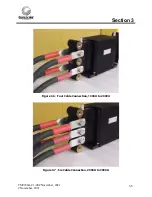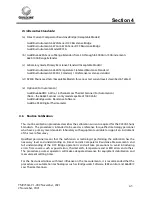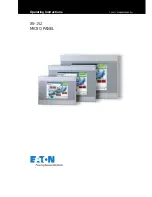
Section 4
TM9230A-C1-002 November, 2021
2 November, 2021
4-1
4.0
CALIBRATION AND PERFORMANCE VERIFICATION
4.1
Introduction
The following section describes the calibration and performance verification procedures for the
9230A Series of Precision DC Current Shunt Standards. It is recommended that Shunt Standards be
calibrated over at least 3 test current points. Where no forced air convection fan is used shunt test
points at nominal 5 W, 10 W power dissipation levels and the specified full scale current are
recommended. Where the model 92310 Forced Convection Unit is used shunt test points at nominal
10 W, 25 W power dissipation levels and the specified full scale current are recommended. When a
shunt is to be used as a precision low resistance standard a 1 watt power diissipation level is
recommended. Where the measurement system test current capability is limited below that of the
shunt itself, the test current points can be set at 10, 25 and 100 % of the maximum power level
capability. The listed points in Table 2 are for most values.
4.2
Calibration Overview
This calibration procedure covers the entire range of the 9230A Series of Precision DC Current Shunt
Standards. The 9230A calibration procedure typically requires only a 1
Ω
resistance standard for
the full range of measurement requirements. It is important to measure and report ambient
temperature conditions so that measurements can be repeated in other locations or suitable
additional uncertainties can be applied for local in use conditions.
Calibration is normally performed with the shunt standard set up on a bench top where the
ambient air temperature can be monitored and kept to within
±
2
º
C. For ambient air temperature
monitoring purposes with a natural convection setup measure the air temperature approximately
20 mm above the bench top and about 75 mm away from the left or right edge of the shunt base.
Where a model 92310 forced air convection fan is used to force air downward into the top of the
shunt standard measure the air temperature approximately 50 mm above the top surface of the
fan unit.
4.3
Calibration Interval and Performance
It is recommended that the 9230A series be calibrated or verified on either the manufacturer’s
recommended 6 month or 1 year interval. As with all shunt standards it is highly recommended
that past history be used to determine drift rates. Generally, shunt standards will drift in value
more significantly in the first 12 months. After the initial 12 months, drift specifications are
improved for the following year(s) for all models provided the shunt has not been subjected to
extreme environmental or test conditions.
Each 9230A is manufacturered to provide some of the best (i.e. lowest) uncertainies when
compared to other commercially available shunt standards. After recalibration the user should
determine the Resistance Calibration Uncertainties by applying a uncertainty calculation that
includes uncertainties for drift, standards and equipment used, the calibration and laboratory
environment, and other uncertainties applicable to that calibration.
Summary of Contents for 9230A Series
Page 2: ......










































